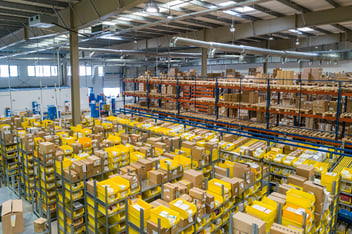Discover how logistics services can enhance the client experience and improve customer satisfaction.
The Importance of Client Experience in Logistics
Client experience plays a crucial role in the success of any logistics operation. In today's competitive business landscape, customers have higher expectations than ever before. They want their orders to be delivered quickly, accurately, and with excellent customer service. Failing to meet these expectations can result in dissatisfied customers, negative reviews, and even the loss of business. That's why focusing on enhancing the client experience is essential.
A positive client experience in logistics can lead to several benefits. Firstly, it can help build strong relationships with customers, leading to repeat business and customer loyalty. Satisfied customers are more likely to choose your logistics services again in the future and recommend them to others. Additionally, a great client experience can differentiate your logistics company from competitors. When customers have a positive experience with your services, they are more likely to choose you over other providers.
Furthermore, an excellent client experience can contribute to improved operational efficiency. When customers are satisfied with the logistics services they receive, they are less likely to encounter issues or make complaints. This reduces the need for troubleshooting and problem-solving, allowing your logistics team to focus on other important tasks. Overall, prioritizing client experience in logistics can lead to happier customers, better business outcomes, and a competitive advantage in the market.
Understanding the Role of Logistics Services
Logistics services play a crucial role in the supply chain, connecting manufacturers, suppliers, and customers. They involve the management of various activities, such as transportation, warehousing, inventory management, and order fulfillment. The primary goal of logistics services is to ensure that products are delivered to the right place, at the right time, and in the right condition.
In the context of enhancing the client experience, logistics services are instrumental in meeting customer expectations and delivering a seamless experience. For example, efficient transportation services help ensure timely deliveries, reducing the risk of delays or missed deadlines. Warehousing services provide secure storage for products, minimizing the chances of damage or loss. Inventory management allows for accurate tracking of stock levels, enabling prompt order fulfillment. By understanding the role of logistics services, businesses can leverage them effectively to enhance the client experience and meet customer demands.
Benefits of a Customer-Centric Approach
Adopting a customer-centric approach in logistics can bring numerous benefits to both the logistics provider and the client. Firstly, it allows for a better understanding of customer needs and preferences. By actively listening to customer feedback and analyzing their behavior, logistics companies can tailor their services to meet specific requirements. This leads to higher customer satisfaction and loyalty.
A customer-centric approach also promotes collaboration and partnership between the logistics provider and the client. By aligning goals and working together, both parties can achieve mutual success. Logistics providers can gain valuable insights from their clients, such as market trends, product demand, and upcoming promotions, which can inform their planning and operations. On the other hand, clients benefit from a logistics provider who understands their business and can provide customized solutions.
Moreover, customer-centric logistics services contribute to improved efficiency and cost-effectiveness. By focusing on what matters most to the customer, unnecessary steps or processes can be eliminated, streamlining operations and reducing costs. This optimization ultimately benefits the client by providing them with faster, more reliable, and cost-efficient logistics services.
Overall, a customer-centric approach in logistics is a win-win situation for both the logistics provider and the client. It fosters stronger relationships, enables mutual success, and drives continuous improvement.
Choosing the Right Logistics Provider
Choosing the right logistics provider is a critical decision that can significantly impact the client experience. When selecting a logistics partner, several factors should be considered to ensure a seamless and satisfactory experience for your clients.
Firstly, assess the provider's capabilities and expertise in handling your specific industry's logistics requirements. Look for experience and knowledge in areas such as transportation, warehousing, and order fulfillment. A provider with industry-specific expertise is more likely to understand your unique needs and deliver tailored solutions.
Secondly, evaluate the provider's technology and systems. In today's digital age, advanced technology is essential for efficient logistics operations. Look for providers that offer real-time tracking, inventory management systems, and robust communication channels. These features enable transparency, visibility, and prompt response to any issues or inquiries.
Additionally, consider the provider's network and geographical coverage. Ensure that they have a wide-reaching network and can handle your distribution needs, whether they are local, regional, or global. A well-established network allows for faster deliveries, reduced transit times, and better overall service quality.
Lastly, don't forget to take into account the provider's reputation and customer reviews. Research their track record and seek testimonials from existing clients. Positive feedback and a solid reputation are indicators of a reliable and customer-focused logistics provider.
By carefully evaluating these factors, you can choose the right logistics provider that aligns with your business goals and enhances the client experience.
Implementing Strategies for Enhancing the Client Experience
To enhance the client experience in logistics, businesses can implement several strategies and best practices. These strategies aim to improve various aspects of the client journey, from order placement to final delivery and beyond.
Firstly, investing in technology is crucial. Implementing a robust transportation management system (TMS) can provide real-time visibility into shipments, allowing customers to track their orders at any time. This transparency builds trust and reassures customers that their products are in safe hands. Additionally, utilizing a customer portal or online platform can enable smooth communication and self-service options, such as order placement, tracking, and returns.
Secondly, effective communication is key. Keeping clients informed about their shipments, including any delays or issues, is vital for managing expectations. Proactive communication, through email notifications or SMS alerts, demonstrates a commitment to customer service and helps prevent surprises or disappointments. Timely updates can also enable clients to adjust their plans or inform their own customers accordingly.
Furthermore, providing personalized and flexible solutions can greatly enhance the client experience. Offering customized delivery options, such as specific time windows or special handling instructions, shows attentiveness to individual needs. Flexibility in order modifications, returns, and exchanges also contributes to customer satisfaction and loyalty.
Lastly, continuously collecting and analyzing customer feedback is crucial for ongoing improvement. Implementing surveys or feedback mechanisms allows clients to voice their opinions and suggest areas for enhancement. This feedback should be actively reviewed and used to identify areas of improvement, address pain points, and refine the client experience.
By implementing these strategies, logistics providers can enhance the client experience, exceed customer expectations, and build long-lasting relationships.





Leave a Comment